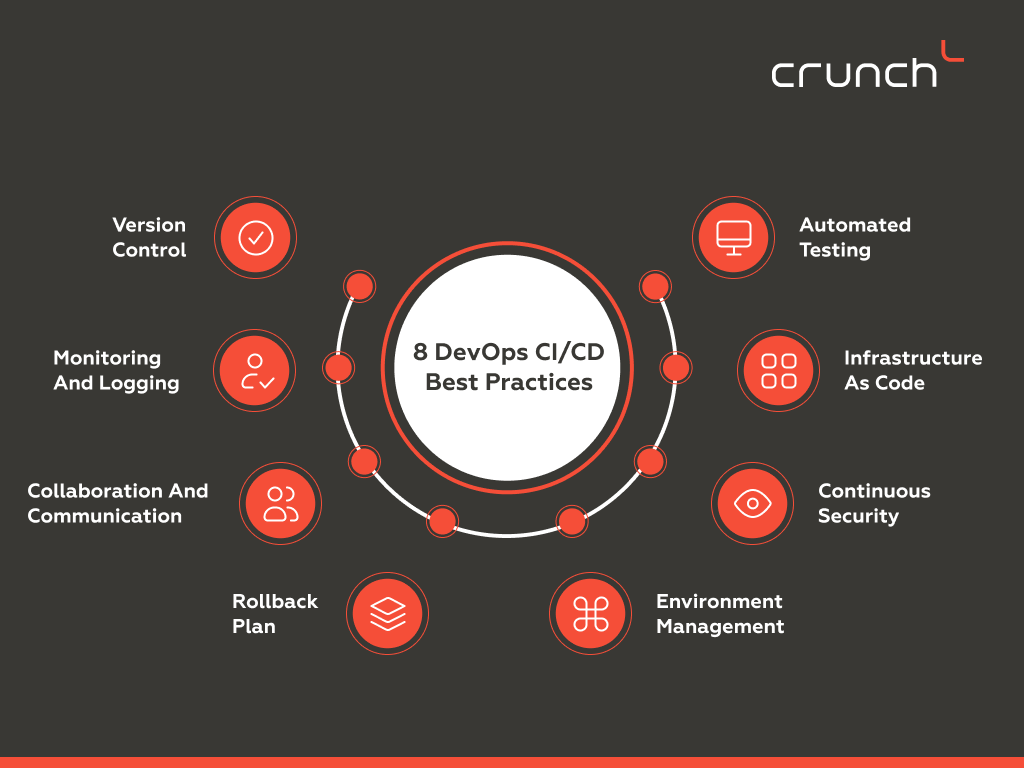
CI/CD methodology acts like a turbocharger for software development, streamlining testing and deployment processes, and accelerating the pace of delivery. With automated feedback loops, development teams can detect and correct issues at an early stage, mitigating risks and reducing errors. By adopting CI/CD practices, businesses can lower development costs, enhance collaboration, and boost customer satisfaction, enabling them to stay ahead of the competition.
CI/CD is a game-changer for software development, providing teams with the tools they need to take their products to the next level. That’s why we are eager to discuss this topic with you.
Why Use Our CI/CD Best Practice Guide
CI/CD (continuous integration/continuous deployment) is a system or a concept of a toolchain that facilitates continuous deployment of newly implemented features. CI is about continuous test checks – whether a new feature passes the automated test suite. Whereas CD is all about building and delivering new versions of software.
But why do we need to understand and use CI/CD best practices for DevOps? Here are some key points:
Faster Development Time: By automating many of the development processes, you can get your code to market faster, which means that you can respond to market demands more quickly and stay ahead of the competition.
Improved Quality: By catching bugs and errors earlier in the development cycle, you can produce higher-quality code that is more reliable and stable. This can reduce downtime and customer complaints.
Lower Costs: By automating many of the development processes, you can reduce the amount of time and effort required to complete tasks, which can lower costs and improve the efficiency of your team.
Improved Collaboration: By using CI/CD best practices, you can create a more collaborative work environment, which can lead to a more efficient and cohesive team.
CI/CD best practices are essential for DevOps because they help you work faster, more efficiently, and with fewer errors. By using these practices, you can produce higher-quality code, reduce costs, and improve collaboration, all of which are essential for success in today’s competitive market.
We can give you a lot of fancy terms, but the bottom line is there’s no way you’d not benefit from implementing CI/CD practices for DevOps.
5 Top CI/CD Best Practices to Implement ASAP
Let’s delve into the top CI/CD best practices and how they can benefit businesses:
1) Version Control
Version control is a system for tracking changes to code over time. By implementing version control, businesses can manage their code changes in a central repository, easily collaborate with team members, and ensure that everyone is working with the most up-to-date code. This practice helps businesses maintain a record of changes and makes it easier to revert to a previous version if necessary.
2) Monitoring and Logging
Monitoring and logging include collecting data from software applications to gain insight into their performance and identify issues. By monitoring their applications, businesses can identify and resolve issues quickly and optimize their software for better performance.
This one helps you out with understanding how your applications are being used and how they can improve them. Monitoring and logging tools such as Splunk, New Relic, and Nagios can be used to implement this practice.
3) Collaboration and Communication
Collaboration and communication involve ensuring that team members are working together effectively and communicating regularly. By promoting collaboration and communication, businesses can reduce errors, prevent delays, and ensure that everyone is working towards a common goal.
This practice also enables teams to stay aligned with business goals and adjust their processes as necessary. Collaboration and communication tools such as Slack, Jira, and Confluence can be used to implement this practice.
4) Configuration Management
Configuration management helps to ensure that applications and infrastructure are configured correctly, consistently, and reliably, reducing the risk of errors and misconfigurations. By automating the configuration process, teams can ensure that configurations are standardized, reducing the time and effort required to configure and deploy applications and infrastructure.
5) Rollback Plan
Plus, it’s imperative to lay out a Rollback Plan when implementing CI/CD DevOps practices. This entails putting in place a well-defined procedure to fall back to the previous version of the software/application if any unforeseen problems occur during the deployment process. Regularly practicing and refining this plan helps DevOps teams quickly respond to and resolve any issues and minimize downtime.
Via the utilization of these best practices, businesses can benefit from faster, more efficient software development processes with fewer errors. They can also improve the quality of their software by catching issues early on and testing it more thoroughly.

4 Additional CI/CD Best Practices for DevOps
These additional CI/CD best practices are not necessarily mandatory for every DevOps implementation, but they still can provide significant benefits in certain situations. Let’s go into more specifics on this matter.
1) Automated Testing
Automated testing is a critical part of any CI/CD pipeline. By automating testing, you can catch bugs and errors early, allowing you to fix them before they become major issues. Automated testing also allows you to achieve a higher level of code quality and ensure that changes to the code don’t break existing functionality.
Automated testing is a key component of the main CI/CD practices for DevOps, but it is important to ensure that all types of testing, including unit, integration, and end-to-end testing, are included in the process.
2) Infrastructure as Code
IaC is a best practice for managing infrastructure in a consistent and efficient way. It allows you to manage infrastructure using the same tools and processes as your application code, ensuring consistency across your environments.
IaC is not an essential element of the primary DevOps CI/CD practices, but it can offer considerable advantages in automation, consistency, and efficiency, making it an additional best practice.
3) Continuous Security
Security is paramount in today’s world where data breaches and vulnerabilities can lead to significant financial and reputational damage for businesses of all sizes.
The CI/CD system provides access to codebases and deployment credentials, making it a prime target for cyber-attacks. Storing credentials in private repositories for automation purposes is also common. To mitigate such risks, it’s crucial to isolate CI/CD systems and put them on secure internal networks. This can be achieved through the implementation of VPNs, robust two-factor authentication, and identity and access management systems.
These measures can enforce the principle of least privilege and restrict exposure to potential threats. To ensure security throughout the development process, DevSecOps practices should be implemented right from the start. Let alone that more and more leaders invest in security these days.
4) Environment Management
One additional practice that businesses can implement today to enhance their CI/CD process is Environment Management. This involves ensuring that development, testing, and production environments are consistent, secure, and reliable. One way to achieve this is by using infrastructure as code (IaC) and automation tools to deploy environments quickly and efficiently. By doing so, businesses can mitigate the risks of configuration drift and unexpected behavior that can result from inconsistencies across environments.
Proper Environment Management can help improve the reliability and security of the CI/CD pipeline and minimize the likelihood of issues arising in production environments. By taking proactive measures to optimize their environments, businesses can streamline their CI/CD process and accelerate the delivery of high-quality software.
While these additional CI/CD best practices are not mandatory for every DevOps implementation, they can help to improve the quality of your software, reduce downtime, and deliver value to your customers faster. The ball is in your court.

In layman’s terms, the main CI/CD practices for DevOps focus on automating the software development process, while the additional CI/CD practices help to ensure that the software is of high quality, secure, and reliable and that the development team works collaboratively to achieve the common goal of delivering value to customers.
Crunch as a Trusted DevOps Services Provider
As a trusted and innovative DevOps services provider, Crunch has been at the forefront of empowering organizations of all sizes to adopt cutting-edge CI/CD best practices throughout their software development lifecycle. Our seasoned team of DevOps engineers is constantly focused on KPIs during project execution, ensuring that every phase of the development process is optimized for peak efficiency and minimum downtime. Plus, we proudly share our extensive knowledge of CI/CD best practices with our esteemed clients, providing them with the tools they need to succeed in today’s ever-evolving business landscape.
The Projects
Our esteemed client’s platform was expertly crafted to aggregate top-tier enterprise data and deliver comprehensive analytics to end users. However, to scale their business and accelerate their growth, they realized the need to embrace a cutting-edge DevOps culture and streamline their delivery and deployment process. In their quest for innovation, they sought our assistance in adopting the best-in-class CI/CD practices, revolutionizing their overall delivery process, and significantly minimizing the risk of disruptions. We were thrilled to partner with them and provide the guidance they needed to achieve their business objectives.
To achieve optimal results, our technical team was tasked with a multitude of complex objectives, including enabling seamless Continuous Integration and Continuous Delivery, migrating essential core operations to the trusted AWS cloud platform, simplifying error detection processes to catch potential issues before release, and accelerating the overall software deployment process. Through our innovative approach and unwavering commitment to excellence, we were able to exceed expectations and deliver unparalleled results.
Results
What started out as a mere short-term project blossomed into a long-lasting 3-year partnership. Our dedicated team went above and beyond to assist our clients in achieving a remarkable 73% reduction in costs through the power of automation. Moreover, we took great care in improving the overall quality of their software, effectively reducing functional defects and boosting efficiency, resulting in an astounding 6 times faster deployment rate. Our unwavering commitment to success and unparalleled expertise propelled our clients to new heights, solidifying our position as their trusted partner for all their future endeavors.
Final Thoughts
For any leader worth their salt, now is the time to act and take advantage of the many benefits that CI/CD can offer.
It’s vital to consider and implement the best Continuous Integration/Continuous Deployment (CI/CD) practices for your DevOps strategy. With CI/CD, you can significantly reduce your software development lifecycle and accelerate your time-to-market, giving you a competitive edge in your industry. Additionally, by automating manual tasks and simplifying error detection, you can improve the overall quality and minimize the risk of costly disruptions. By embracing CI/CD best practices, you’ll be able to innovate more quickly, deliver more frequently, and maintain a high level of customer satisfaction. It’s on you, always has been.



![How Much Does It Cost to Build AI Solutions In 2025 [Ultimate Guide]](https://crunch.is/wp-content/uploads/2024/06/steve-johnson-1FD-E7Ioblw-unsplash-scaled.jpg)



